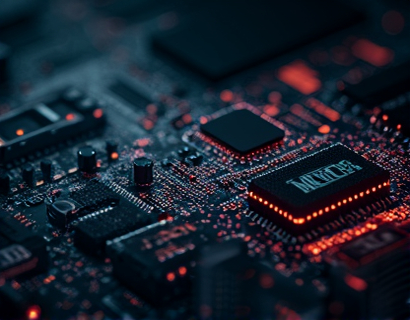Next-Gen Smart Contract AMMs: Revolutionizing DeFi Trading and Liquidity Management
The landscape of decentralized finance (DeFi) is rapidly evolving, driven by technological advancements and the increasing adoption of blockchain technology. At the heart of this transformation are Automated Market Makers (AMMs), particularly those powered by smart contracts. These innovative platforms are redefining how liquidity is managed and trades are executed in the crypto space. This article delves into the next generation of smart contract AMMs, exploring how they unlock optimal DeFi trading and liquidity management, and offer a seamless and efficient market interaction experience for crypto traders and DeFi enthusiasts.
Understanding Smart Contract AMMs
Traditional AMMs rely on algorithms to determine asset prices and manage liquidity pools, often using liquidity provision models based on constant product or constant sum formulas. However, next-gen smart contract AMMs take this a step further by leveraging advanced cryptographic techniques and decentralized governance models. These AMMs are built on robust smart contracts that execute trades and manage liquidity in a transparent, tamper-proof, and automated manner.
The smart contract nature of these AMMs ensures that all transactions are immutable and verifiable, reducing the risk of manipulation and enhancing trust among users. The decentralized aspect means that no single entity controls the AMM, making it more resilient to censorship and failures.
Optimizing Liquidity Management
One of the key advantages of next-gen smart contract AMMs is their superior liquidity management capabilities. Traditional AMMs often suffer from liquidity provision challenges, where providers may face impermanent loss and limited trading pairs. Next-gen AMMs address these issues through dynamic liquidity allocation and advanced fee structures.
Dynamic liquidity allocation allows the AMM to adjust the distribution of liquidity across different pools based on market demand and volatility. This ensures that liquidity is always available where it is most needed, reducing the risk of liquidity traps and improving overall market efficiency. Additionally, smart contracts can implement fee structures that incentivize liquidity provision during periods of high volatility, encouraging more participants to contribute to the pools.
Another significant feature is the use of over-collateralization and collateral management. Next-gen AMMs can require higher collateral ratios during volatile periods, ensuring that the risk of liquidation is minimized. Smart contracts can automatically adjust collateral requirements based on real-time market conditions, providing a more stable and secure trading environment.
Automating Trading Strategies
Automated trading strategies, or bots, have long been a staple in traditional finance, but their implementation in DeFi through smart contract AMMs brings a new level of sophistication and accessibility. These bots can execute complex trading algorithms, manage positions, and adapt to market conditions in real-time, all without human intervention.
Smart contract AMMs support a wide range of trading strategies, from simple market making to advanced arbitrage and hedging. For instance, liquidity providers can deploy smart contracts that automatically rebalance their positions based on predefined criteria, such as price movements or trading volume. This automation not only enhances efficiency but also reduces the emotional bias that often affects human traders.
Moreover, the transparency of smart contracts allows traders to audit and understand the logic behind trading bots, fostering a higher level of trust and collaboration within the DeFi community. Developers can also build and deploy custom bots, creating a vibrant ecosystem of innovative trading solutions.
Enhancing Market Interactions
The integration of next-gen smart contract AMMs into the DeFi ecosystem significantly enhances market interactions. The seamless and efficient execution of trades reduces slippage and improves order fulfillment, providing a better experience for traders. The real-time updates and transparent pricing mechanisms ensure that all participants have access to the most accurate and up-to-date market data.
Furthermore, the decentralized nature of these AMMs promotes greater inclusivity and accessibility. Users from around the world can participate in trading and liquidity provision without the need for intermediaries, lowering barriers to entry and democratizing access to financial markets.
The interoperability of smart contract AMMs is another significant advantage. They can seamlessly integrate with other DeFi protocols and blockchain networks, creating a cohesive and interconnected financial system. This interoperability enables cross-chain liquidity provision, allowing assets to be traded and managed across different blockchains, thus expanding the potential for growth and innovation.
Challenges and Considerations
While next-gen smart contract AMMs offer numerous benefits, they also come with challenges that need to be addressed. Security remains a paramount concern, as smart contracts are only as secure as their code. Bugs, vulnerabilities, and smart contract hacks can result in significant losses. Therefore, rigorous testing, auditing, and community review are essential to ensure the reliability and security of these platforms.
Regulatory compliance is another area that requires attention. As DeFi continues to grow, regulatory frameworks are evolving, and AMMs must navigate these changes to operate legally and sustainably. Developers and platforms need to stay informed about regulatory requirements and implement necessary compliance measures.
User education is also crucial. The complexity of smart contract AMMs can be daunting for new users. Providing comprehensive documentation, tutorials, and user-friendly interfaces can help demystify these platforms and encourage broader adoption.
Future Prospects
The future of next-gen smart contract AMMs looks promising, with ongoing developments poised to further enhance their capabilities. The integration of advanced technologies such as machine learning and artificial intelligence can lead to more intelligent and adaptive trading strategies. These technologies can analyze vast amounts of data to predict market trends and optimize trading decisions in real-time.
Additionally, the rise of layer 2 solutions and scalability protocols will address some of the current limitations of blockchain networks, enabling faster and more cost-effective transactions. This will make smart contract AMMs even more appealing for high-frequency trading and large-scale liquidity provision.
Interoperability will continue to be a key focus, with efforts to create standardized protocols and frameworks that facilitate seamless interactions between different DeFi platforms and blockchains. This will not only enhance user experience but also foster a more unified and robust DeFi ecosystem.
Conclusion
Next-gen smart contract AMMs represent a significant leap forward in DeFi trading and liquidity management. By leveraging the power of smart contracts, these platforms offer unparalleled transparency, security, and efficiency. They empower traders and liquidity providers with advanced tools and automated strategies, making the crypto market more accessible and inclusive. As the technology continues to evolve, the potential for innovation and growth in the DeFi space is immense, promising a future where decentralized finance is not just an alternative but the mainstream.











































